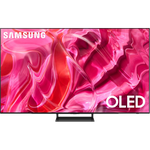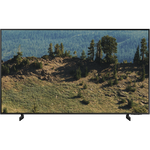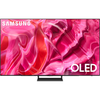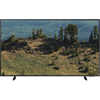A comparison of specs, key information, reviews, and best pricing from top retailers
Last updated -- hours ago | Report incorrect information
What we think

The PerfectRec TV team Learn more
Updated January 10, 2024·
If you're prioritizing overall picture quality, particularly for gaming and movies, the Samsung S90C with OLED technology is superior, offering excellent contrast, color accuracy, and viewing angles. It also performs better in dark rooms but is more expensive. However, if you're looking for a more budget-friendly option, the Samsung AU8000 is less expensive. This LCD TV is suitable for general content like news, cartoons, and reality TV, and has good upscaling for lower resolution content. It won't perform as well in a dark room and is not as well-suited for gaming due to a lower refresh rate and response time. Give Feedback
this description is based on the product variant with some specs and product variant with some specs. At the time of writing, the variant with some specs cost some dollars and the variant with some specs cost some dollars.
Advantages of the Samsung S90C (OLED)
- Very good for bright room
- Excellent for dark room
- Best in class for gaming
- Excellent for movies & TV
- Very good for sports
- Excellent for news, talk, & other TV
- Excellent for cartoons & animation
- Excellent for use as monitor
- Very good for upscaling
- Very good motion processing
- Best in class viewing angle
- Best in class reflections
Advantages of the Samsung AU8000 (LCD)
- The Samsung AU8000 (LCD) has no clear advantages over the Samsung S90C (OLED).
Key differences
Picture Quality
9.4


6.6
10.00/10
CONTRAST
6.71/10
9.2/10
COLOR VOLUME SCORE
6.3/10
RGB OLED
PANEL TYPE
LED
QD-OLED
PANEL SUB-TYPE
VA
The Samsung S90C (OLED) has excellent picture quality, while the Samsung AU8000 (LCD) has only fair picture quality.
Movies & TV
9.4


5.9
10.00/10
CONTRAST
6.71/10
10.0/10
BLACK UNIFORMITY
6.9/10
8.0/10
UPSCALING
7.5/10
Yes
HDR10 SUPPORT
Yes
Yes
HDR10+ SUPPORT
Yes
No
DOLBY VISION SUPPORT
No
The Samsung S90C (OLED) is excellent for movies & TV, while the Samsung AU8000 (LCD) is poor.
The Samsung S90C excels in movie and cinematic TV watching because of its OLED technology, providing perfect black uniformity and excellent contrast, bolstered by effective local dimming that elevates the viewing experience in dark scenes. Conversely, the Samsung AU8000, with its LCD screen, struggles with lower contrast, lacks local dimming, and doesn't achieve the same black uniformity, resulting in a less immersive experience for movies and cinematic content.
Sports
8.7


6.5
8.2/10
MOTION PROCESSING
6.0/10
144Hz
REFRESH RATE
60Hz
10.0/10
INPUT LAG SCORE
10.0/10
8.0/10
UPSCALING
7.5/10
7.8/10
SDR BRIGHTNESS SCORE
7.1/10
Yes
HLG SUPPORT
Yes
The Samsung S90C (OLED) is very good for sports, while the Samsung AU8000 (LCD) is only fair.
The Samsung S90C OLED TV has a superior response time and motion processing, which results in clear images with minimal blur during fast-moving sports scenes. On the other hand, the Samsung AU8000 LCD TV's response time and motion processing are less advanced, leading to a fair performance that can result in more noticeable blur during similar high-speed content.
Gaming
10.0


5.8
10.0/10
RESPONSE TIME SCORE
5.9/10
10.0/10
INPUT LAG SCORE
10.0/10
8.2/10
MOTION PROCESSING
6.0/10
100.0/100
GAMING LOCAL DIMMING
0.0/100
8.4/10
GAME HDR BRIGHTNESS SCORE
5.8/10
The Samsung S90C (OLED) is best in class for gaming, while the Samsung AU8000 (LCD) is poor.
The Samsung S90C offers the best performance for gaming due to its superior response time and lower input lag, making it more responsive and suitable for fast-paced gaming; the Samsung AU8000, due to its poor response time, doesn't provide as seamless an experience, potentially leading to blurring during quick movements. The S90C also comes with a higher refresh rate, enhancing the smoothness of gameplay, which is especially noticeable in gaming contexts compared to the lower refresh rate of the AU8000.
Cartoons & Animation
9.3


6.9
9.2/10
COLOR GAMUT SCORE
6.1/10
9.2/10
COLOR VOLUME SCORE
6.3/10
7.8/10
SDR BRIGHTNESS SCORE
7.1/10
8.8/10
COLORS OUT OF THE BOX SCORE
7.2/10
9.8/10
GRAY UNIFORMITY
6.8/10
The Samsung S90C (OLED) is excellent for cartoons & animation, while the Samsung AU8000 (LCD) is only fair.
The Samsung S90C (OLED) offers superior color performance with excellent colors out of the box and a larger color gamut, enhancing the vibrancy and variety of colors in cartoons and animation, whereas the Samsung AU8000 (LCD) has only good colors out of the box and a fair color gamut, which may result in less vivid and diverse colors. Additionally, the S90C's better color volume contributes to more accurate and richer coloring in varied scenes, while the AU8000's fair color volume might not display shades as accurately and could appear more washed out in comparison.
News, Talk, & Other TV
9.1


6.7
7.8/10
SDR BRIGHTNESS SCORE
7.1/10
8.0/10
UPSCALING
7.5/10
The Samsung S90C (OLED) is excellent for news, talk, & other TV, while the Samsung AU8000 (LCD) is only fair.
The Samsung S90C OLED TV excels in upscaling and displays vibrant colors straight out of the box, which makes it excellent for watching news, talk shows, and other TV programs. On the other hand, the Samsung AU8000 LCD TV has lower capabilities in upscaling and does not match the color quality of the S90C, deeming it fair for the same type of content.
Bright Room
8.5


6.3
10.0/10
VIEWING ANGLE
5.5/10
7.8/10
SDR BRIGHTNESS SCORE
7.1/10
8.0/10
HDR BRIGHTNESS SCORE
5.7/10
10.0/10
REFLECTIONS SCORE
7.8/10
The Samsung S90C (OLED) is very good for bright room, while the Samsung AU8000 (LCD) is only fair.
The Samsung S90C has a very good HDR brightness and handles reflections extremely well, making it more suitable for bright rooms, while the Samsung AU8000, despite having good SDR brightness, performs less effectively against reflections and has lower HDR brightness, making it less ideal for brightly lit environments.
Cost
$1,375


$648
$0
$500
$1,000
$1,500
$2,000
$2,500
The Samsung S90C (OLED) has a price of $1,375 and the Samsung AU8000 (LCD) costs $648.

Let Us Help Find Your Perfect TV
Find your new TV
Give feedback
We’re constantly working to improve.
How the Samsung S90C (OLED) and the Samsung AU8000 (LCD) compare to other TVs
Spec Comparison
| Samsung S90C (OLED) | Samsung AU8000 (LCD) |
GENERAL | |||
|---|---|---|---|
| Price | |||
$1,375 | $648 | ||
Brand | |||
Brand | Samsung | Samsung | |
Release Date | |||
Release Date | April 11, 2023 | March 4, 2021 | |
Full name | |||
Full name | QN65S90C | UN65AU8000 | |
Screen Size | |||
Screen Size | 65" | 65" | |
Screen Resolution | |||
Screen Resolution | 4K | 4K | |
TV FEATURES | |||
|---|---|---|---|
Operating System | |||
Operating System | Tizen | Tizen | |
Sound Quality Score | |||
Sound Quality Score | 6.4/10 | 6/10 | |
NextGen Ready | |||
NextGen Ready | Yes | No | |
HDMI Ports | |||
HDMI Ports | 4 | 3 | |
Coax Ports | |||
Coax Ports | 1 | 1 | |
DISPLAY QUALITY SCORES | |||
|---|---|---|---|
Picture Quality Score | |||
Picture Quality Score | 9.4/10 | 6.6/10 | |
Bright Room Score | |||
Bright Room Score | 8.6/10 | 6.4/10 | |
Gaming Score | |||
Gaming Score | 10/10 | 5.8/10 | |
Movies & TV Score | |||
Movies & TV Score | 9.5/10 | 5.9/10 | |
Sports Score | |||
Sports Score | 8.8/10 | 6.5/10 | |
PHYSICAL | |||
|---|---|---|---|
Dimensions w/o Stand (H x W x D) | |||
Dimensions w/o Stand (H x W x D) | 32.7" x 56.9" x 1.6" | 32.7" x 57.1" x 1" | |
Dimensions with Stand (H x W) | |||
Dimensions with Stand (H x W) | 35.3" x 56.9" | 34.4" x 57.1" | |
Weight without Stand | |||
Weight without Stand | Unknown | 46.1 lbs | |
VESA Mount | |||
VESA Mount | 300 x 200 | 400 x 300 | |
DISPLAY | |||
|---|---|---|---|
Color Depth | |||
Color Depth | 10 bit | 10 bit | |
Black Frame Insertion | |||
Black Frame Insertion | Yes | Yes | |
Auto Low Latency Mode | |||
Auto Low Latency Mode | Yes | Yes | |
Contrast | |||
Contrast | 10/10 | 6.7/10 | |
Local Dimming | |||
Local Dimming | 10/10 | 2.5/10 | |
SOUND | |||
|---|---|---|---|
Speaker Setup | |||
Speaker Setup | 2.1 | 2.0 | |
Speaker Power | |||
Speaker Power | Unknown | 20 W | |
Dolby Atmos | |||
Dolby Atmos | Yes | Bypass only | |
DTS:X | |||
DTS:X | No | No | |
Shopping
Samsung S90C (OLED)
See more
Dig into reviews and images
Techradar
John Archer | August 2023
"Samsung S90C is the company's attempt at making its QD-OLED technology more affordable. You get high-end pictures, great processing, top gaming tech, and a sharp design."
Samsung AU8000 (LCD)
See more
Dig into reviews and images
USA Today
Michael Desjardin | April 2023
"To put it directly: you’d never see a mid-range 4K TV hitting this black levels half a decade ago. AU8000 plays the part of a higher-end TV thanks to its sleek design. If you’re upgrading to a smart TV for the first time, the software is a great way to dip your toes in the streaming water."
Get a great deal on the Samsung S90C (OLED) or the Samsung AU8000 (LCD)
About Samsung
Samsung, a South Korean electronics manufacturer, holds the title of being the largest global TV vendor in terms of units sold. They offer a diverse lineup of TV products that cater to various budget ranges. A notable achievement in recent years is the development of Quantum Dots, a technology that enhances color reproduction, resulting in richer and more vibrant hues. Samsung TVs are well-regarded for their high manufacturing quality and user-friendly software, making them an excellent choice for consumers seeking an intuitive viewing experience.
Give feedback
We're constantly perfecting our model
TV guides you might be interested in
More comparisons for you
FAQs
FAQs about TVs
Why trust us
This information was produced and vetted by the PerfectRec TVs team. We are a product research and recommendation organization that meticulously reviews and evaluates the latest TV information and makes it digestible for you.
By the numbers
385
TVs evaluated
33,110
TVs stats compiled
21
Proprietary TVs ratings developed
122,130
Recommendations made
18,320
Consumer hours saved
About the TV team
Joe Golden, Ph.D
CEO and TVs Editor
Joe is an entrepreneur and lifelong electronics enthusiast with a Ph.D in Economics from the University of Michigan.
Jason Lew
Staff Expert & Software Engineer
Jason is a staff expert and software engineer that has been making laptop recommendations for 7 years and moderates one of the largest laptop subreddits.
Chandradeep Chowdhury
Staff Expert & Software Engineer
Chandradeep is a staff expert and software engineer and expert in televisions and monitors. He’s been making monitor recommendations for ten years.
Jaime Roldán
TVs Expert
Jaime is a Colombia-based TV expert. He is an electronics engineer with 8 years of experience in the telecom sector and has been making TV recommendations for 12 years.







